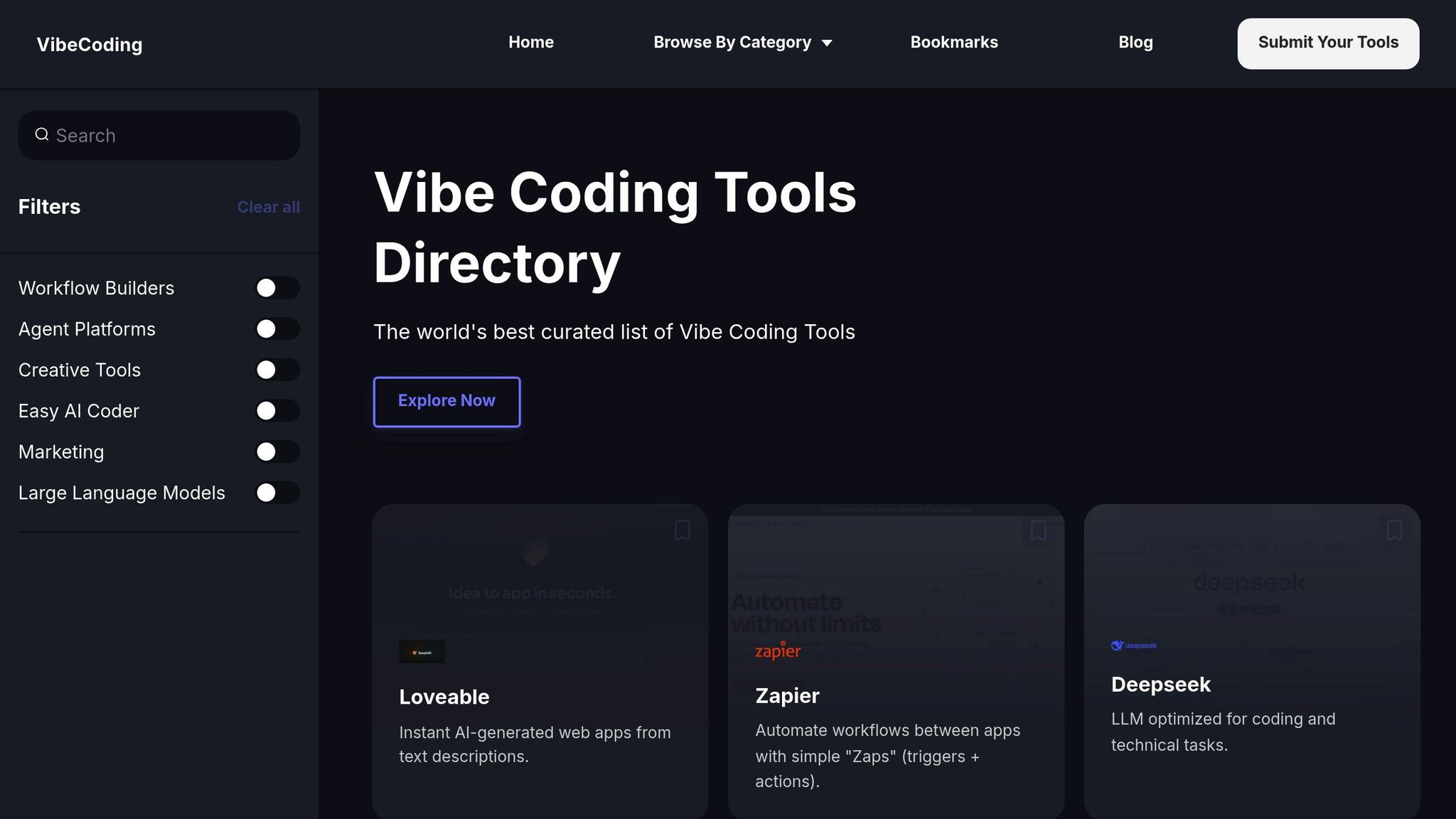Want better AI-generated code? Start here. Prompt evaluation means testing how well your instructions guide AI to write code that fits your needs. It helps you create cleaner, more efficient code, saves debugging time, and ensures reliable results.
Key Takeaways:
- Write Clear Prompts: Be specific, set requirements, and provide context.
- Test Systematically: Use step-by-step, single-prompt, or comparison methods.
- Fix Common Problems: Address output variability, unclear metrics, and context sensitivity.
Quick Start:
- Start with simple prompts and improve step by step.
- Use tools like the Vibe Coding Tools Directory for testing and learning.
- Avoid vague or overly complex instructions.
This guide breaks down everything you need to write better prompts and evaluate them effectively.
Basic Evaluation Concepts
Main Evaluation Parts
When assessing prompts, three key elements come into play: prompt clarity, context quality, and output accuracy. These factors work together to ensure effective and reliable prompting.
-
Prompt Clarity: Ensures the instructions clearly communicate intent.
- Use specific and straightforward language.
- Include any necessary technical details.
- Define the expected output format.
-
Context Quality: Frames the problem effectively.
- Provide relevant background information.
- Include specific details about the use case.
- Outline any constraints or limitations.
-
Output Accuracy: Measures how well the generated code meets the requirements.
- Check for functionality that aligns with the prompt.
- Review the structure and organization of the code.
- Ensure proper implementation of error handling.
By focusing on these components, testing can help measure and improve prompt effectiveness.
Testing Methods
Testing helps validate how well prompts perform. Here are the primary methods used:
| Testing Method | Purpose | Best Used When |
|---|---|---|
| Step-by-Step | Validates individual components | For breaking down complex prompts |
| Single Prompt | Tests the performance of a full prompt | For straightforward requests |
| Comparison | Compares variations of similar prompts | For optimizing prompt structure |
The Vibe Coding Tools Directory platform incorporates all these methods. For example, when testing a sorting algorithm prompt, step-by-step testing might include:
- Initial Setup: Confirm the programming language, imports, and function definitions are correct.
- Core Logic: Check the algorithm for correctness and efficiency.
- Edge Cases: Test scenarios like empty arrays, single elements, or duplicate values.
For single prompt testing, evaluate the entire output to identify any gaps between the requirements and the results. Comparison testing, on the other hand, allows you to experiment with different prompt versions to determine the most effective approach.
These testing methods provide actionable feedback, helping refine prompts and improve outcomes. This leads to cleaner, more efficient code that aligns with the goals outlined earlier.
Prompt Engineering for Beginners - Tutorial 15 - Evaluation ...
sbb-itb-7101b8c
Beginner Tips and Methods
These practical tips simplify the process of refining prompts, making it easier for beginners to get started.
Step-by-Step Improvement
Using the Vibe Coding Tools Directory, begin with straightforward prompts and gradually enhance them as you evaluate the output quality:
| Stage | Focus Area | Key Action |
|---|---|---|
| Initial | Basic Structure | Write simple, single-task prompts |
| Intermediate | Context Addition | Add specific requirements and constraints |
| Advanced | Test Scenarios | Handle different input types |
For example, start with a basic prompt:
Write a function to calculate factorial
Then refine it to include additional requirements:
Write a function to calculate factorial that handles negative numbers and includes input validation
By improving prompts step by step, you can achieve better code quality and more precise outputs.
Writing Clear Prompts
Clear prompts lead to better results. To write effective prompts, focus on these key elements:
- Be specific: Clearly define what you need.
- Provide context: Explain the purpose or background.
- Set precise requirements: Include constraints or standards.
For instance:
Write a merge sort implementation in Python that:
- Handles arrays up to 1,000,000 elements
- Includes time complexity analysis
- Uses type hints
This level of clarity helps ensure the generated code aligns with your expectations.
Common Mistakes to Avoid
Here are some common errors to watch out for when crafting prompts:
1. Overcomplication
- Avoid unnecessary technical details or combining unrelated requirements.
2. Vagueness
- Don’t use ambiguous terms or leave out critical details like programming language or framework.
3. Poor Structure
- Keep tasks separate and ensure requirements are clearly outlined. Don't skip format specifications.
Stick to essential details to keep prompts focused and effective. For example:
Create a function that sorts an integer array in ascending order using quicksort
Evaluation Tools and Learning Materials
Having the right tools and resources can make prompt evaluation more efficient and effective. Here are some key resources to consider:
Vibe Coding Tools Directory

The Vibe Coding Tools Directory serves as a one-stop shop for AI coding and prompt evaluation tools. Here's what it offers:
| Feature | Description | Why It Matters |
|---|---|---|
| Tool Collection | A curated list of AI coding assistants | Helps you find tools that match your experience level |
| Beginner Tutorials | Step-by-step guides for tools like Replit and Cursor | Teaches you how to use tools in practical scenarios |
| Resource Library | Tips and examples for prompt engineering | Improves your ability to write effective prompts |
The directory is regularly updated to stay aligned with the latest trends in AI coding.
Learning Resources
These materials are designed to help you build a solid foundation and advance your skills in prompt evaluation:
| Resource | Focus Area | Highlights |
|---|---|---|
| Andrew Ng's "Vibe Coding 101" | Core Concepts | Breaks down the basics in an easy-to-understand way |
| Replit Tutorials | Practical Application | Offers an interactive platform to practice coding and prompts |
| Cursor Guides | Advanced Skills | Covers in-depth techniques for crafting better prompts |
Each resource is tailored to help you grow, whether you're a beginner or looking to refine advanced techniques.
Testing Platforms
A good testing environment is essential for evaluating prompts effectively. AI-integrated code editors provide instant feedback, making it easier to assess and refine your prompts. The Vibe Coding Tools Directory includes platforms with project-based environments, allowing you to apply your skills in practical scenarios. These tools not only help you improve but also prepare you for more advanced evaluation strategies covered in the next section.
Summary
Main Points
Prompt evaluation is a key skill for making the most of AI-assisted coding. Here's a quick look at the core ideas we've discussed:
| Evaluation Aspect | Key Takeaway | Application |
|---|---|---|
| Clear Prompts | Use precise language and specific instructions | Leads to better code output with fewer revisions |
| Testing Methods | Follow a structured approach to refine prompts | Ensures consistent and reliable results |
| Tool Selection | Choose the right platforms for evaluation | Speeds up learning and improves outcomes |
Mastering these basics and applying them methodically can greatly enhance your coding process.
Getting Started
Here are some practical steps to kick off your prompt evaluation journey:
1. Explore Tools
Check out the Vibe Coding Tools Directory to find AI coding assistants that match your experience level. Many beginner-friendly tools come with built-in testing environments, making it easier to practice and refine your prompts.
2. Start Small
Begin with straightforward coding tasks to build your skills. Focus on:
- Writing clear and specific prompts
- Testing one variable at a time
- Keeping track of what works and what doesn’t
3. Leverage Learning Materials
Dive into tutorials and guides available in the Vibe Coding Tools Directory. These resources are tailored to help beginners grasp the essentials of prompt engineering and apply them effectively in coding projects.

